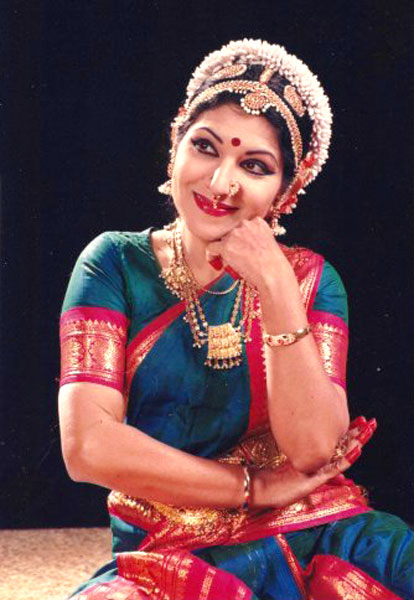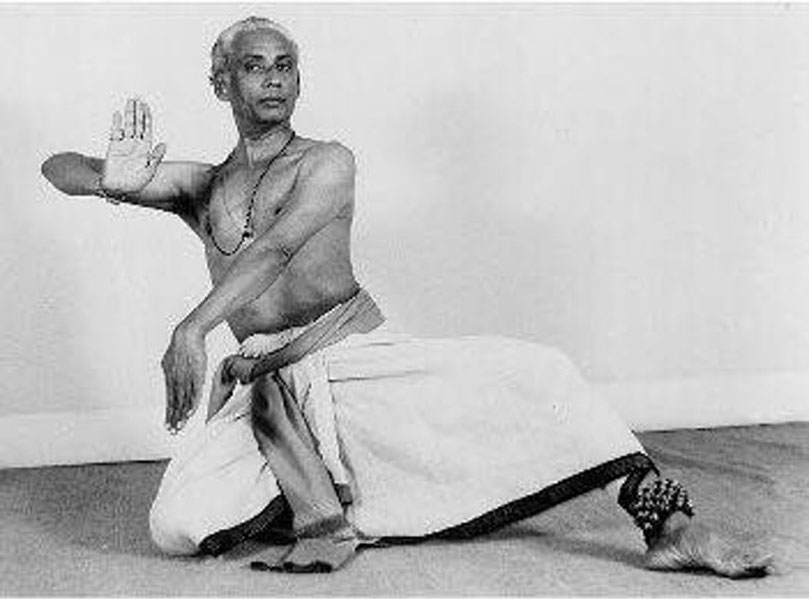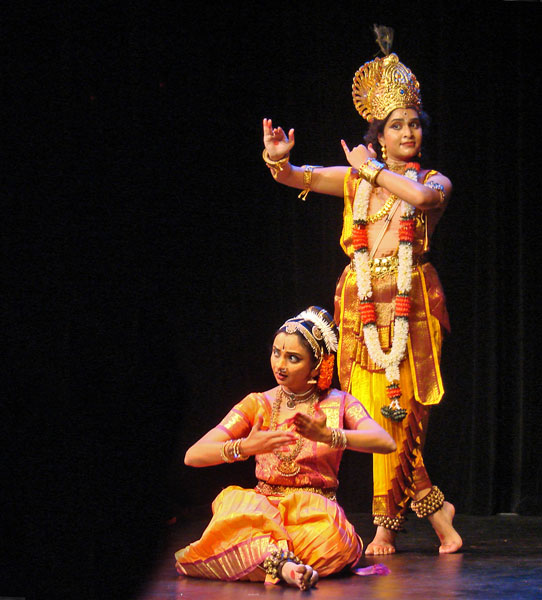Rhythms of Kuchipudi
It was love at first sight when I saw Kuchipudi for the very first time when I was barely ten years old. My mother took me to learn the dance form from the illustrious guru, Vempati Chinna Satyam who had me spellbound with his graceful movements and iconic poses when he demonstrated the dance. He was a great visionary who had walked from his Kuchipudi village to Madras with merely two rupees and a pocketful of dreams and succeeded in establishing a centre of excellence for Kuchipudi in Chennai. Before he started the Kuchipudi Art Academy in 1963, he initially taught dance in two small rooms down the street close to my home. I became one of his earliest students since my mother nurtured a hope that I would imbibe some Andhra culture. I suspect that her motivation was more to encourage a struggling artist than to make a dancer out of me as her earlier attempts to teach me dance had proven futile. But this time around, my initiation to Kuchipudi transformed my life; my love affair with dance began when I discovered the dancer in me.
The Nawab of Golconda, Habul Hussan Qutub Tanisha, after witnessing a dance performance, gifted the group of travelling bards land at
Kuchelapuram village in the 17th century.
Kuchipudi (pronounced Koochipoodi) is a living dance tradition of Andhra Pradesh named after the village Kuchelapuram or Kusilava puram (village of actors/travelling bards) in Krishna district which became the home of Kuchipudi dancers in the 17th century. Dance flourished in Andhra from the third century B C and reached the zenith of glory during the rule of the Vijayanagar kings in the 15th and early 16th century. After the fall of the Vijayanagar Empire there was a steady decline due to constant invasions and the musicians and dancers migrated South for survival. Some of them were granted land in Thanjavur by Achyuthappa Naicker where they popularised what is now known as the Melattur Bhagavatha Mela. The dance troupe traditionally consisted of male dancers who travelled across villages and performed dance dramas based on religious themes on temporary stages that were set up near the temples.
A Nawab’s gift
In the 17th century, the Nawab of Golconda, Habul Hussan Qutub Tanisha, witnessed a dance performance which impressed him profoundly. Tanisha immediately gifted the group of travelling bards land at Kuchelapuram village with a stipulation that they continue to perform and propagate their glorious dance tradition. This gesture transcended linguistic and religious barriers and changed the course of Kuchipudi dance. Thanks to the generous patronage the dancers could settle down and centralise, consolidate and further develop the brilliant dance style.
It is believed that Yati Narayana Teertha and his disciple Siddhendra Yogi were the pioneers who dedicated their lives to resurrecting and propagating this glorious dance form in all its pristine beauty. Siddhendra Yogi was the harbinger who turned Kuchelapuram into a dancing village Kuchipudi by persuading the community to dedicate every male child to the God of Dance. He infused new aesthetic spirits by composing masterpieces like the Bhama Kalapam and became the force that gave eternity to Kuchipudi.

The dance format underwent several transformations along with the historical changes in the land. During the early part of the middle ages when the Veera Saiva cult held sway over Andhra, dynamic and virile dance dramas based on Siva Leelas were popularly performed in the Yaksha Gana style. Later, the Vaishnavaite Bhakti movement gained popularity and a dance drama format closely related to the Bhagavatha Mela tradition evolved. The Vishnu Leela operas used to be performed by male dancers known as Kuchipudi Bhagavathulu. In the early 20th century three prominent artists — Vedantam Lakshminarayana Sastri, Vempati Venkatanarayana Sastri and Chinta Venkataramayya — contributed tremendously to the enhancement of the dance.
Later it took an entirely new direction when Vedantham Lakshmi Narayana Sastry took the bold step of teaching women dancers and paved the way for future gurus.
Vempati Chinna Satyam ushered a renaissance of Kuchipudi in post independent India and was largely responsible for placing it firmly on the world map of dance. He was a brilliant performer, teacher and choreographer, who systematised the dance format without sacrificing its purity and made it more sophisticated to appeal to the larger global audiences. Renowned Bharatanatyam dancers like Vyjayantimala Bali, Rhadha, Lakshmi Viswanathan, Rathna (Papa) Kumar, Hemamalini and many others learnt Kuchipudi under the maestro’s tutelage at the Kuchipudi Art Academy. One of his senior disciples, Rathna (Papa) Kumar, established the first Kuchipudi dance institute in the United States in 1975 to popularise and propagate the remarkable Vempati ‘Bani’ (style). Talking about how destiny brought Kuchipudi into her life, Rathna says, “When I say Kuchipudi changed my life, I am not saying it for effect. I had learnt a little Kuchipudi from Vedantham Jagannadha Sarma when I was about eight, but that did not impact me as much as my brief stint under Vempati Pedda Satyam and advanced training a year later under Vempati Chinna Satyam. I was at a very vulnerable point in my life at that time, having just recovered from a terrible attack of small pox that had scarred my whole body, destroyed my eyesight, and pushed me to a psychological low. I was 14 and miserable.”
I found Kuchipudi exciting and unpredictable, its moves and body language so different from those of Bharatanatyam, which
I had been doing for 10 years.
— Rathna Papa Kumar, Kuchipudi dancer
But then the miracle happened; she found Kuchipudi. “It was exciting and unpredictable, its moves and body language so different from those of Bharatanatyam, which I had been doing for 10 years. I fell in love with the sweeping movements, the leaps, the sheer energy and vibrancy of the dance form and immersed myself into learning it as thoroughly as I could. I never dreamed, at that time, that it would one day become an integral part of my life!”
Like all classical dance forms of India, Kuchipudi too traces its roots to the ancient classical treatise on arts, the Natya Shastra and shares several similarities with Bharatanatyam. But the repertoire is vastly different with each style having distinct characteristics that define it. In the traditional Kuchipudi dance drama format each character is introduced through a short preliminary dance called Pravesa Dharavu before the story unfolds. Until the last century, all the female roles used to be performed by men who dressed as women. Some of them continue to keep this great traditional format alive with their excellent portrayal. The late Vedantam Satyanarana Sarma was renowned for his outstanding portrayal of female heroines in dance dramas such as Satyabhama in Bhama Kalapam, Usha in Usha Parinayam, Mohini in Mohini Rukmangada, Sasirekha in Sasirekha Parinayam and Gollabhama in Gollakalapam. Dancer Kala Krishna says that it takes more than two hours for him to don the makeup and costume for Satyabhama but when he performs, people completely forget his age and gender. Vempati Chinna Satyam further enriched the traditional repertoire by choreographing and staging many more dance dramas like Sri Krishna Parijatham, Ksheera Sagara Madhanam, Srinivasa Kalyanam, Vipranarayana and Sakuntalam to name a few.
Yati Narayana Teertha composed the Krishna Leela Tarangini as a libretto for a dance drama and introduced rhythmic dance syllables at the end of the canto. Excerpts from it are often performed as a Tarangam by soloists where they elaborate stories of Krishna and build it up to a culmination of pure dance performed while balancing on a brass plate. Some dancers add water in a pot and balance it on the head in addition and dance to elaborate rhythmic patterns. The combination of the exposition of popular stories through dance interspersed with mnemonics makes Tarangam a most enjoyable dance experience.

Bhama Kalapam, a dramatic dance expression called Prabandha Nartanam composed by Siddhendra Yogi, is the quintessential dance replete with eloquent emotions and intricate dance patterns. The Kuchipudi Kavutvams are distinctly different, distinctive from their Bharatanatyam counterparts. The Vinayaka, Mayura or Simhanandini Kavutvam is performed with the dancer spreading coloured rice powder on the stage and covering it with a white cloth or paper and dancing on top of it to preset music. At the end of the segment a beautiful painting of Vinayaka, peacock or lion is created by the artist through footwork according to the precise pattern of each dance.
Vasanthalakshmi Narasimhachari, wife and dance partner of the multi-talented guru, the late Narasimhachari says, “If a man is to be described as one who considers his life and art inseparable, it would be my husband and guru Sri M V Narasimhachari. Having imbibed the nuances of music and dance from his own father, he went on to enrich the repertoire of Kuchipudi with his exquisitely beautiful creations like Shivaleela, Subhadra Arjuneeyam and Ravana Mandodari, to name a few. Now our daughters Lavanya and Lasya are doing commendably in taking our work further while aesthetically expanding the horizons of art.”
Kuchipudi today is a highly respected and sought after dance style in India and abroad. The dance that used to be taught only to Brahmin boys in the Kuchipudi village became inclusive in the 20th century and opened its doors to every devotee of art irrespective of caste or creed. It no longer remains an exclusive male bastion with women dancers outnumbering men today and even dressing and performing the roles of male characters.
When the art became more flexible and adaptable, it reached out to a far wider dance circle. Wherever art flourishes, so does life and as Havelock Ellis says: “Dancing is the loftiest, the most moving, the most beautiful of the arts, because it is not mere translation or abstraction from life; it is life itself.”

